|
The Commodity Year in Review and 2008 Outlook
2007 offered a year of dollar weakness and commodity price inflation, supported by massive volatility not seen in decades. The CRB Index of commodities rose more than 25% in less than a year. The dollar broke down as the euro rallied for the second straight year, offering a 33 point run or almost 30% in two years. Crude oil may not have had its largest annual percentage rise but, given it's already inflated price, it made a massive move doubling in price from it's January lows to all time highs.
A housing crash, credit fallout and a Fed led by a less predictable leader has sparked significant economic fears. Commodity price inflation and geopolitical concerns mark a year of green commodity price boards as the bull commodity cycle remained in full swing. However, 2008 will be a different story.
In the coming year we will see a strong U.S. dollar and global economic weakness force a recession in commodity prices, sparking a long overdue price correction in many major commodity sectors. This contrarian outlook may be a bit shocking but the average analyst, newsletter writer and broker will likely convince us that commodity prices have more to climb and we will look back, around this time next year, and probably wish we had followed this report. The first bear retracement in commodities in the new Millennium is upon us.
Top 5 Bull Plays for 2008
Coffee
U.S. Dollar
Cotton
Sugar
Orange Juice
Top 5 Bear Plays for 2008
Euro Currency
Canadian Dollar
Gold
Wheat
Crude Oil
Energies
Energy prices skyrocketed in 2007 as geopolitical risk took center stage. Inflation concerns by the Fed, sparked by rising oil prices, did little to stop crude from closing near all time highs to end the year. While $100 is critical from a psychological perspective it does little to determine the long term price outlook for this sector. The short term technical bounce after the market's first real attempt at retracing appears to be the real deal, but January will mark a likely top in a sector well overdue for a massive price correction. Recent winter weather across the U.S. is too little too late and not enough to make supply concerns force a further price surge. The overall tone of this market heading into 2008 is an overbought market that is seeing funds look elsewhere for commodity profits.
Let's look at three main areas affecting this sector:
1) Geopolitical Risk - This is a general term for a very specific problem. Turkey's invasion of Iraq, Iran's nuclear efforts, Israel vs. Lebanon vs. Syria, Pakistan's ex-PM and current political rival gets assassinated, and on and on and on. Can the Middle East temper this unstable market environment? What is priced in and what is unknown? While all the action over the past couple of years gives the feeling of impending escalation, the Bush Presidency, despite all its faults, has doused numerous Middle East fires before they exploded. Unfortunately they keep relighting the fire as well.
2) Supply vs Demand - While estimates and expectations suggest rising demand for oil in 2008, it is often overlooked that global supply remains steady with declining production capacity utilization. So it would seem as if the industry can amp up production to meet rising demand, all else withstanding.
3) Weather - After two devastating years of hurricanes and erratic winter weather the market has gone on to see two years of benign hurricane activity and warm winters. If 2008 is the tiebreaker in a best of five scenario, then which way will the scale tip?
Rising freight prices and implementation of alternative fuel sources and efficient automobiles will curb demand in 2008. Commodity prices act like a rubber band. It stretches and then when it is stretched to the limit it either breaks or snaps back. Energy prices are stretched tight and I expect them to snap back hard and fast in 2008.
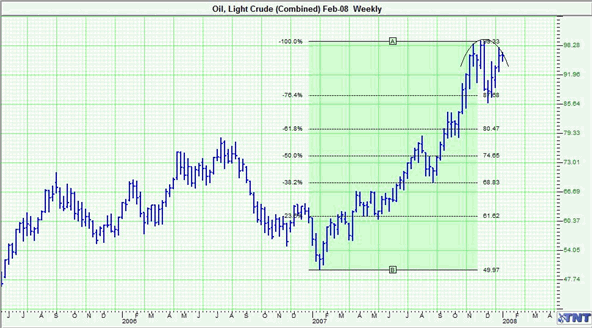
The bottom line for energies is that prices are in hysteria mode and are driven by specs pushing them higher and a bunch of greed stopping sellers from entering the mix. When it falls, it will fall hard and I would not be surprised if volatility peaks to another level when the top gets set; can anyone handle a $10 day in oil? I see a couple of days like that in the near future.
Financials
Stocks offered a mediocre showing in 2007 with single digit returns and massive spikes in the VIX creating a volatile trading environment. The Sharpe Ratio, a measure for fund managers to determine the risk taken to achieve a given profit, has dropped dramatically amongst most funds and suggests that it is becoming riskier to earn a buck in the stock market these days. While volatility is likely to fluctuate in 2008, the market is unlikely to go very far. This will offer an ideal environment for premium collection if done in short term time frames and with patient leg-in entry timing.

In 2008 I expect to see the Fed's unpredictable interest rate policy continue to plague the market, worsened by the housing fallout, a weaker export market due to a rising dollar and rising unemployment. The technical outlook for the S&P appeared ugly heading into the new year, setting up a bear break on Friday that confirmed dual consolidation patterns and a rounding top on a longer term chart. The top set in 2007 barely broke the previous highs and suggests that market psychology may be shifting to a long term top in the market. I expect that 2008 will offer a range of 1510 to 1300, a relatively tight year-long range given current and anticipated volatility.
The Fed marked both 2007 and the inaugural year of Ben Bernanke's tenure by creating a volatile environment of unpredictable policy shifts and economic forecasting. While efforts have been made to make Fed decisions more transparent, the end result has been more interpretation arguments than the last 4 years of Greenspan's tenure combined. There is little light at the end of the tunnel in 2008 as bond prices have shown expansive volatility, the Fed has shown no ability to create intermediate- or long-term expectations for rates or the economy. All we have is a housing crisis, a global capital problem and a slumping economy. I expect bonds to break out of both sides of the recent range with highs above 119 and lows below 112. When volatility diminishes ahead of a Fed meeting, I look to play near-term long strangles for volatility expansion as I expect massive price expansion and contraction throughout the year.
The dollar will ultimately be the determining factor for 2008. After a long and strong downtrend in the dollar we will finally see the U.S. dollar regain its footing and develop a reversal pattern bringing the dollar to 88 on the index by year end. Currencies are often the easiest to argue a directional view and the hardest sector to predict, simply because there are so many global factors in play. However, the turn in the dollar is based on a few simple reasons - exports, tourism and China.
While the U.S. has sustained our economy despite a ton of problems, it did so because of a weak dollar offering strong exports and a slew of foreign investment and tourism. The tide will soon turn, however, as the powerhouse euro currency is creating a major problem overseas. The euro's incredible run, a 15% rally in under a year, has set in motion a virtual freeze on exports and tourism dollars throughout Europe. The U.S. faced a similar problem back in 2002 when the dollar was running above 120 and the U.S. implemented a weak dollar policy to improve economic growth. Despite the U.S.'s housing problems, the E.U. actual pumped more money in than the Fed has, suggesting a possible dilution of their currency and a long term trend reversal.
China is tough topic. Everyone knows that China is offering some incredible growth opportunities, an independent currency that is very strong, and is experiencing an influx of foreign investment. However, China's economists are no slouches - they may not know how to relate to the public through some of the more bizarre PR issues I have ever seen - but they know how to implement proper monetary policy. Part of proper monetary policy is slowing growth to a point in which infrastructure, demand for raw commodities and general inflation is kept to a minimum. Double digit annual growth flies in the face of this type of monetary policy. While it is important for the yuan to remain strong and stable, it has diverged so much from the U.S. dollar that it is causing unsustainable growth. The yuan will retrace in 2008, and global demand for commodities will diminish because of it.
The Canadian dollar has seen an unbelievable run due to rising raw material prices (commodities make up approximately half of Canada's exports). Spec interest in the currency spiked it to 1.10 on the U.S. dollar and created the largest move in under a year in the currency's history - over 30% since February! I look for the Canadian, and the Aussie, dollar to see significant retracements in 2008 as tops in energy and metal prices, as well as a strong dollar, force specs to flock for the exits.
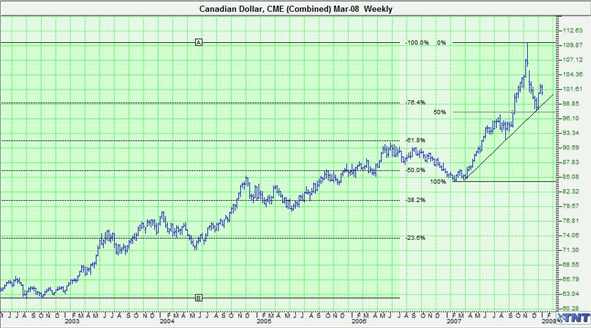
Grains
A historic year in grains came despite a massive corn crop, as acreage shifts, weather issues and global demand spikes helped to bring grains to relative contract highs. Wheat's devastating frosts and acreage shift helped to boost that grain to extreme all-time highs and a global thirst for under-planted soybeans surged that market to double digits and beyond. Corn, a trailer by comparison, has still seen prices more than double the 2006 lows. Rice, a sleeper in the group, has sustained one of the biggest continuous rallies in commodity history as it has risen over 400% in just over 5 years (more than doubling since 2005). While grains have long-term bullish fundamentals, I expect 2008 to bring a massive price correction.
Soybeans have seen a drop in planted acreage and a rise in global demand, with a buildup to a China demand that will likely bring 'beans in the teens' before it is all said and done. Spiking demand for bean oil has been met with disproportionate supply of this key derivative. This is a great bull market, but it has just about stretched the rubber band as tight as it is going to go. I expect a top between current prices and $14, with a likely top in the low $13 area.
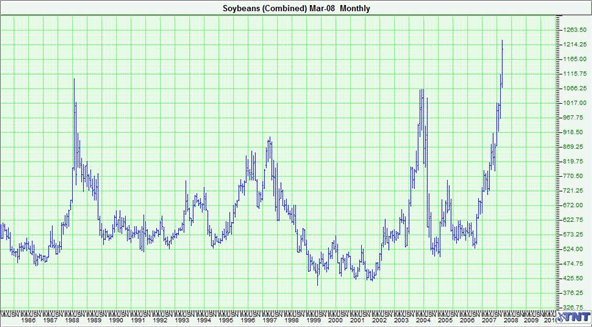
Wheat is so overbought it makes the incredibly bullish fundamentals behind this rally seem less intriguing. Two seasons and a secondary acreage shifts will turn wheat back to the $6 area in 2008.
Corn is supported by rising ethanol demand, sparked by the Bush Administration's impressive PR and subsidization program. Can the oversupply be offset by the demand boost and long term bullish fundamental prospects? If wheat and beans sustain such high prices then the substitutive demand for corn will help to support prices. But if, and when, beans and wheat fall then watch out! Corn could see $3 prices in 2008, but not before testing a critical $5 area.
Rice has been one of the best bull plays I have ever seen, as supply issues in China and global demand increases have allowed rice to hit historical highs. This may be the one grain that could make an extended run, with the potential for another 30-40% move up in 2008. However, this thin market is in risky territory after breaking through the critical price resistance seen from previous spike highs in the past two decades. The bottom line is if I am going to play the upside, I will tread lightly.
Meats
Cattle prices remained channeled for much of 2007 as sustained high prices built in the rising feed costs as opposed to an over supply run to slaughter that many expected. Global export issues also helped to create a foggy fundamental picture that is likely to continue into 2008. While prices appear to be unable to set fresh highs, it is difficult to time a major price correction given the market's resiliency of buying dips and general lack of volatility. Given the frequency of Mad Cow it is likely that 2008 will see a news catalyst to a major drop in underlying prices. I look to develop straight long-term put spreads in anticipation of 30% price correction in 2008.
Hogs have had a tumultuous year despite staying within a wide price range. Rising demand has been hit hard with supply shocks and caused a choppy intermediate term trading environment. The market is unlikely to test extreme highs or extreme lows in 2008 and offers a good opportunity to buy reasonable price dips in the 50s and sell tops in the upper 70s.
Metals
Gold prices ended 2007 at 28-year highs and a seventh consecutive annual gain. The market has been supported by spiking commodity prices and a weak U.S. dollar, which prices gold on a global level. Because of the weak U.S. dollar the rising gold price appears less inflated to foreign buyers. This year will be quite a different story as gold will suffer from the perfect storm of retracing commodity prices, reduced inflation fears and a strong U.S. dollar.
The one supporting argument for gold is a potential flight to quality if the stock market tumbles harder than expected and bonds remain at low payoff levels. Silver is technically very strong and may diverge from gold, but ultimately is a strong sell in 2008. Platinum is on a historic run, showing a more than 30% runup in under a year. Look for a top to be set in platinum in January as the inventory deficiencies and South African supply problems are likely built into the market. Copper has shown its general inability to retest the $4 highs and should falter due to a China slowdown.
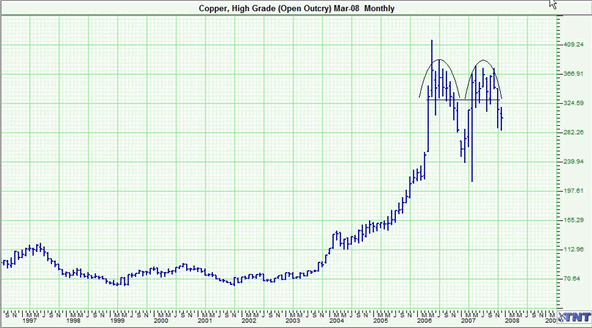
Softs
Coffee remained on a solid weekly and monthly trend line support as rising demand combined with drought problems in Brazil to continue coffee's steady climb in 2007. Vietnam may have had a blockbuster crop in 2007, but the monsoon rains and general quality issues make much of the crop useless. Brazil's drought almost annihilated the 2008 coffee season, the bigger supply season of the country's bi-annual cycle. Saved at the last moment, the crop was still hit hard enough by the drought to likely reduce the overall yield of the world's biggest coffee producer. Mexico's growing region was hurt by hurricanes and Kenya's crop is virtually non-existent. Years ago coffee production was consolidated to mainly South America. Since coffee has expanded its growing areas, it has diversified its supply risk and caused a once volatile commodity to become more tempered and predictable. In 2008 we may experience the first real global supply deficiency since the new Millennium and coffee may once again become a market of extreme volatility. I look for coffee to break above $2 this year and offer bulls a lot to celebrate. I will watch for bull call spreads and straight long-term out of the money calls.
Cocoa experienced a bull run in 2007, supported by devastating crop infestations and disease and an Ivory Coast meltdown. The Ivory Coast produces the bulk of the world's cocoa and, when combined with Ghana's supply, essentially controls world cocoa prices. In 2007, the Ivory Coast continued to have an unstable political climate and little suggests that it will change in 2008. Peace treaties, disarmaments and French intervention seem to be short-lived efforts in a country wrought with violence, improper wealth distribution and too many fighting factions. Throw in hedge fund interest, global increases in demand and an ugly supply situation and we have the potential for further gains in 2008.
Orange juice has been on a wild ride for years as the hurricanes of 2004/05 and canker fungus and citrus greening have devastated the Florida OJ crop. An acreage shift in California has also helped to diminish the U.S. OJ supply, which once provided more than 1/3 of the world's supply of the vitamin-C rich treat. Technically, the market hit a historic top at $2.10 and has since had a perfect Fib retracement that offers price support going into 2008. This past week's Florida frost had a sell the news effect that begs bulls to buy the dip ahead of a potential late winter weather season and critical hurricane season ahead. Brazil has balanced the supply problems with their own bumper crop, but the upcoming year may see a bull surprise in regards to Brazils' next crop as citrus greening is wreaking havoc throughout much of the growing region.
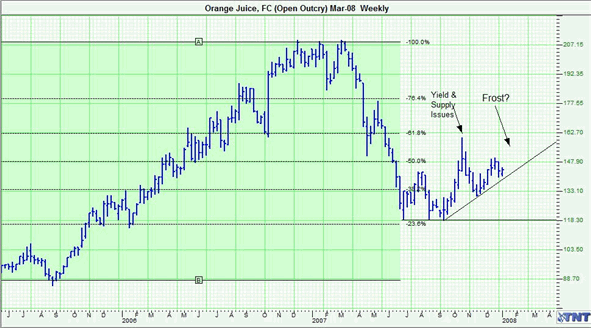
Cotton finally got out of the doldrums as a Delta region acreage shift to profitable corn planting left supply in cotton a bit low. Horrendous weather in Pakistan and India didn't help matters either. The cycle of oversupply is likely over and 2008 should offer a solid rally in a market that is overdue for a cycle shift to the bull side. Throw in a breakout to the upside of a long-term consolidation pattern and the volatility over the next several months may offer call buyers a solid premium spike.
Sugar ended the year finally turning a corner back to the upside. Many fundamentalists may wonder why, as one of the worst oversupply situations in any commodity in history will likely plague this market for the next couple of years. However, the enforcement of a ruling that stops the European Union from unloading half of the world's oversupply of sugar on the open market may just save this market from further collapse. Moreover, the rise in corn prices may bring sugar ethanol to the forefront of the energy crisis as it still offers a cheaper method for ethanol production than corn. The U.S.'s ban on importation of Brazilian based sugar ethanol ends in mid-2009, but recent efforts by the Brazilian government to push for an early termination of the ban may ultimately pay off. Sugar call premium was dirt cheap for the last half of 2007, as readers of our Weekend Commodities Review are well aware. Now premium is a bit pricier, but value can still be found in deep out of the money long-term plays. With volatility starting to pick up, these calls may not be out of the money for very long.
Last, but not least, is the often forgotten lumber market. Because of the lack of liquidity this is normally a market to avoid. However, the market has clear long-term cycle lows and cycle highs and we are fast approaching a great value buy. I look at 200-220 area for a great value entry to ride this up to 320 in the upcoming year as the worst of the building freeze is over, even if the foreclosure situation still has the worst in front of it.
James Mound is the head analyst for www.MoundReport.com, and author of the commodity book 7 Secrets. For a free email subscription to James Mound's Weekend Commodities Review and Trade of the Month, click here.
|